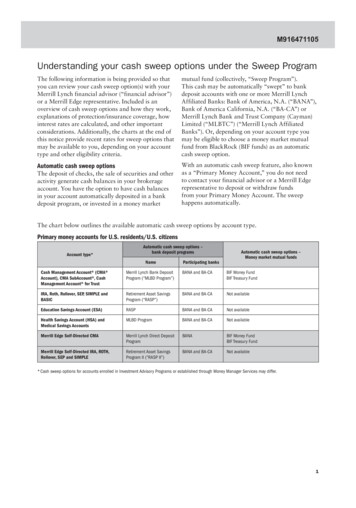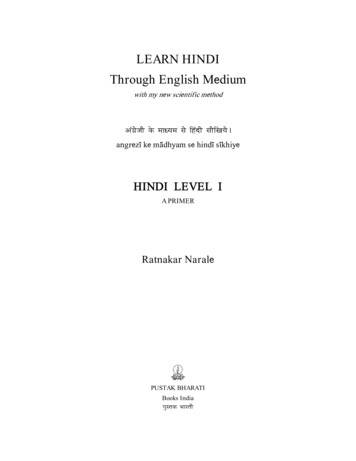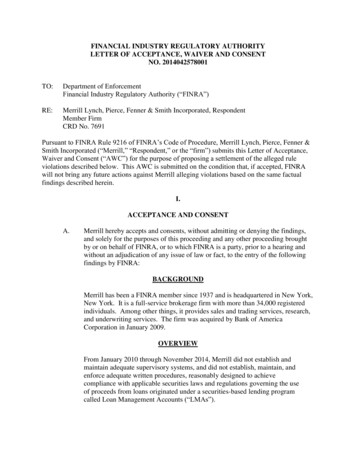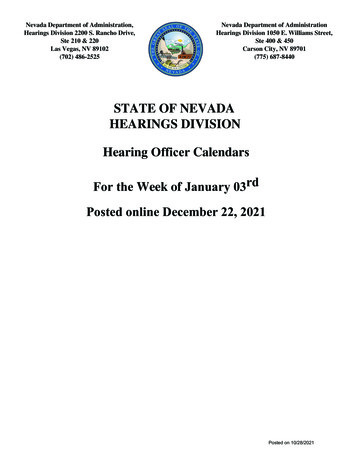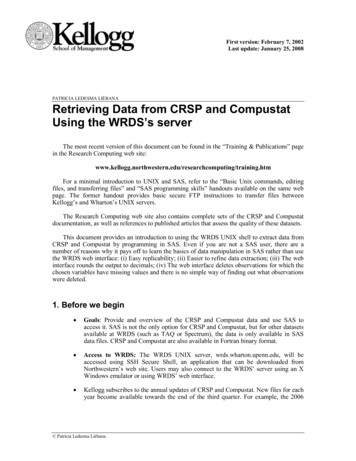
Transcription
First version: February 7, 2002Last update: January 25, 2008PATRICIA LEDESMA LIÉBANARetrieving Data from CRSP and CompustatUsing the WRDS’s serverThe most recent version of this document can be found in the “Training & Publications” pagein the Research Computing web g/training.htmFor a minimal introduction to UNIX and SAS, refer to the “Basic Unix commands, editingfiles, and transferring files” and “SAS programming skills” handouts available on the same webpage. The former handout provides basic secure FTP instructions to transfer files betweenKellogg’s and Wharton’s UNIX servers.The Research Computing web site also contains complete sets of the CRSP and Compustatdocumentation, as well as references to published articles that assess the quality of these datasets.This document provides an introduction to using the WRDS UNIX shell to extract data fromCRSP and Compustat by programming in SAS. Even if you are not a SAS user, there are anumber of reasons why it pays off to learn the basics of data manipulation in SAS rather than usethe WRDS web interface: (i) Easy replicability; (ii) Easier to refine data extraction; (iii) The webinterface rounds the output to decimals; (iv) The web interface deletes observations for which thechosen variables have missing values and there is no simple way of finding out what observationswere deleted.1. Before we begin Goals: Provide and overview of the CRSP and Compustat data and use SAS toaccess it. SAS is not the only option for CRSP and Compustat, but for other datasetsavailable at WRDS (such as TAQ or Spectrum), the data is only available in SASdata files. CRSP and Compustat are also available in Fortran binary format. Access to WRDS: The WRDS UNIX server, wrds.wharton.upenn.edu, will beaccessed using SSH Secure Shell, an application that can be downloaded fromNorthwestern’s web site. Users may also connect to the WRDS’ server using an XWindows emulator or using WRDS’ web interface. Kellogg subscribes to the annual updates of CRSP and Compustat. New files for eachyear become available towards the end of the third quarter. For example, the 2006 Patricia Ledesma Liébana.
RETRIEVING DATA FROM CRSP AND COMPUSTAT USING THE WRDS’S SERVERCompustat data will become available around August of 2007; CRSP is generallyupdated earlier than Compustat, around June.2. Structure of the WRDS server Wharton Research Data Services (WRDS) provides access to a Sun Solaris serverthat holds datasets to which Kellogg subscribes, as well as software for access. Thisserver can be accessed via the web or via a terminal emulator. The web interface isdescribed in the “Accessing data through Wharton Research Data Services’ webinterface” handout, which can be used by faculty in MBA classes. Software available in the WRDS server includes SAS 8, Fortran 77 and Fortran 90,C, perl, and standard UNIX tools and text editors. As any UNIX server, the WRDS’ system is a hierarchical file system, shown for theWRDS server in the diagram below./wrdshomeusrnwulocaluseridsas 9.1.3sastemp1-sastemp12 (200GB data2 All datasets are stored in the “/wrds” volume. There are 13 “scratch” volumes, named “sastemp0” through “sastemp12”, each with200GB of space. The content of any of these volumes is deleted without warningshould it become full. Thus, make sure to move any needed dataset to your skew3account or your PC. The space used by any one user in a sastemp volume cannotexceed 32GB. You can check the space available in each with the UNIX command“df –k more”. Home directory quotas: Starting August 5, 2004, each user gets a “home” directory,with 750mb of space. If you need to store datasets larger than the space allowed byyour quota, write them in one of the scratch volumes. If you need an increase in yourKELLOGG SCHOOL OF MANAGEMENT
RETRIEVING DATA FROM CRSP AND COMPUSTAT USING THE WRDS’S SERVERhome directory quota, WRDS will do this at an annual charge per year per GB ofspace. Currently the charge is 60 per GB, per year. For old accounts (created prior to the 8/5/04 change), that had two directories(/home/nwu/userid and /projects/nwu/userid), the projects directory now becomes asub-directory of the home directory (see picture below). A symbolic link, the Unixequivalent of a windows shortcut, allows programs that had /projects/nwu/useridhard-coded to run without problems. Default user directory: When a user logs into the server, the default directory or“home directory” is /home/nwu/userid, where userid is the user’s login ID for thesystem, created by WRDS personnel. Users can submit only one job at a time. Do not write any files to “/tmp”.3. Logic of CRSP and Compustat Extended descriptions of CRSP and Compustat are available in the ResearchComputing web puting/compustat.htm Both CRSP and Compustat are collections of files that can best be described asrelational databases: the data in each dataset is spread across various files that can beconceived as related “spreadsheets”. To link these spreadsheets, one must use one ormore variables as to link observations from one table with observations of the other. In general terms, there are three types of files or tables in CRSP and Compustat: fileswith information that identifies individual securities or firms (header files), files withhistorical individual level information (panel data, such as annual financialstatements or daily prices and returns, the promised daily yield on a Treasury bond,etc.) and files with market level information (time series, with information such asinflation, value-weighted returns, total market value, etc). Both CRSP and Compustat have generated unique identifiers for the firms andsecurities they cover. Information such as the company name is hard to match,CUSIPs and tickers may change through the history of a firm or issue; they even maybe re-assigned to different companies or issues. CRSP unique identifiers: In CRSP, each security in the stock file is assigned a uniqueidentifier (PERMNO); each company is given a unique identifier called PERMCO.These numbers are consistent through time, even if CUSIP numbers, tickers orcompany names change. For instruments in the Treasury files, the unique identifier isCRSPID, while in the mutual funds database the identifier is ICDI.KELLOGG SCHOOL OF MANAGEMENT3
RETRIEVING DATA FROM CRSP AND COMPUSTAT USING THE WRDS’S SERVER Compustat’s unique identifiers: In Compustat, each company has a unique identifier,GVKEY, assigned by Standard & Poor’s. This identifier is the one matched withPERMNO by CRSP to create the Merged CRSP/Compustat database. Many use thecombination of CNUM (the 6 digit CUSIP number) and CIC (the two digit CUSIPissue number and a check digit) as the unique identifier. In CRSP, the CUSIPvariable is the concatenation of the CUSIP number and the CUSIP issue number.Thus, CUSIP in CRSP is an 8-digit variable. For more information about CUSIPnumbers, see www.cusip.com. Compustat fiscal years versus calendar years: The Compustat annual files include afiscal year variable (yeara) and a fiscal year-end month of data (fyr). The latter takesvalues from 1 (January) through 12 (December) depending on the month in which acompany’s fiscal year ends. There are some observations with fyr 0 which should bedeleted; data fields for those observations is typically missing.For firms with a fiscal year between January and May, the fiscal year (yeara) lags oneyear behind the calendar year. For example, for a firm with fiscal year-end of April30th (e.g. Heinz Co, with gvkey 5568), a fiscal year (yeara) of 2002 reallycorresponds to April 30th, 2003.For the quarterly files, the situation is similar, except that the calendar yearassignment should be done by quarters. The fiscal year variable in the quarterly filesis called “year”, and the fiscal quarter is “qtr”. The table below spells out the calendardates you should use to match with CRSP data. Notice the quarters for which the yearneeds to be shifted. Example 4 in section 8 walks you through an example ofmatching monthly CRSP data and quarterly Compustat data.Fiscal and calendar yearsQuarter end calendar dateFYRfiscal quarter 1fiscal quarter 2fiscal quarter 3fiscal quarter 4April 30July 31October 31January 31fiscal year 1May 31August 31November 30February 28/29fiscal year 1June 30September 31December 31March 31fiscal year 1July 31October 31January 31fiscal year 1April 30fiscal year 1August 31November 30February 28/29fiscal year 1May 31fiscal year 167September 30October 31December 31January 31March 31April 30June 30July 318November 30February 28/29May 31August 319December 31March 31June 30September 3110January 31April 30July 31October 3111February 28/29May 31August 31November 3012March 31June 31September 30December 3112345 4At the end of this document, there is a list of the datasets included in Kellogg’ssubscription to these datasets.KELLOGG SCHOOL OF MANAGEMENT
RETRIEVING DATA FROM CRSP AND COMPUSTAT USING THE WRDS’S SERVER Time-saving tip for Compustat users: Many users frequently search three ofCompustat’s databases to find a specific company (industrial, research and fullcoverage files). Wharton has combined the three files into one in the SAS version ofthe data (compann.sas7bdat and compqtr.sas7bdat). There is no comparable versionfor Fortran. WRDS created these files so that its web interface can perform thequeries submitted by subscribers using the web interface. The WRDS web interfaceconsists of a number of perl scripts that customize and run SAS programs.4. Searching for a companyTo search for the PERMNO and CUSIP in CRSP, or for CNUM and DNUM in Compustat,you may use the UNIX “grep” command on the names files from the Fortran data collection. Theheader files are in ASCII format.“grep” searches a file line-by-line for a given pattern. Whenever it finds a match for thestring, it prints the corresponding line to the screen. The “-i” switch makes “grep” ignore the caseof the provided string.At the prompt in the WRDS Unix server, use the following commands:For CRSP:grep –i "company name" /wrds/crsp/seqdata/smi/cheadfile.datFor example,grep -i "ibm" 03093830INTERNATIONAL BUSINESS MACHS CO IBMAMERICUS TR FOR IBM SHSBZPAMERICUS TR FOR IBM SHSBZSAMERICUS TR FOR IBM 31-1992063019870731-19920630The columns, left to right, are: PERMNO, CUSIP, Header SIC code, ticker, company name,exchange code and start to end date range for price data.For Compustat:grep –i "company name" /wrds/compustat/seqdata/ina.names(or res.names or fca.names)For example:grep -i "ibm" /wrds/compustat/seqdata/ina.names7370 459200 101 IBMKELLOGG SCHOOL OF MANAGEMENTINTL BUSINESS MACHINES CORP5
RETRIEVING DATA FROM CRSP AND COMPUSTAT USING THE WRDS’S SERVERThe columns, left to right, are: DNUM (industry classification code), CNUM (CUSIP issuercode), CIC (CUSIP issuer number and check digit), SMBL (ticker symbol) and company name.Note that the Compustat names files for Fortran do not include GVKEY. SAS users maywrite a simple program that searches for a pattern in the ticker (SMBL) and company name(CONAME) variables:data busqueda;set comp.namesann;where CONAME contains 'IBM' or SMBL contains 'IBM';proc print data busqueda;The advantage of this program over the “grep” command is that it will query the combinednames file (industrial, full coverage and research names files).5. WRDS’ setup for SAS users SAS library names are already defined in all user accounts. Thus, users can invokethose names without defining them (with a LIBNAME statement) in their programs.The configuration of these LIBNAMES is done within a file called “autoexec.sas” ineach user’s account. Any option or LIBNAME used frequently can be added to thisfile, which is automatically executed by SAS before any other command. Do notmove the autoexec.sas to any subdirectory or it will not work. You can customize your “autoexec.sas”. For example, my personal preferences forthe autoexec.sas:options ls 120 nodate nocenter ps max formdlim ' 'nonumber;title;libname out ' /projects ';These options only have impact on the output (LST) file. They set or eliminate, fromleft to right: the line size (characters printed per line), date, centering of output, pagesize, page delimited (set to a space instead of a page break), page numbering. The“title” statement by itself eliminates the SAS default headline (“The SAS System”) atthe top of every page. I also assign a LIBNAME to a subdirectory in my accountwhere I store some datasets. To follow the examples starting in section 8 below, please create a directory called“projects” in your account (mkdir projects). Include the following statement inyour autoexec.sas and save it:libname out ' /projects';where userid is your WRDS’ login ID. Save the changes in the autoexec.sas; theywill be used in the examples in section 6 below. 6In your autoexec.sas, you will see the following command:KELLOGG SCHOOL OF MANAGEMENT
RETRIEVING DATA FROM CRSP AND COMPUSTAT USING THE WRDS’S SERVER%include '!SASROOT/wrdslib.sas' ;This command calls and executes a SAS programs saved in the directory where SASis installed (/usr/local/sas 9.1.3). It defines all the SAS libnames for data existing inWRDS (whether we subscribe or not. Do not remove this command. A list ofimportant LIBNAMES already assigned by WRDS through the %include statementin the autoexec.sas is provided in the table below:Sample of WRDS pre-assigned LIBNAMESData setSAS librefCorresponding directoryBank /compustat/sasdataCRSPcrspDow Jones averagesDRIFama phlx/wrds/issm/sasdata/wrds/phlx/sasdataSEC Disclosure of Order taThomson Financialtfn/wrds/tfn/sasdata/wrds/irrc/sasdataThe %include SAS statement allows you to bring SAS code stored in a separateprogram file.6. Using SAS sample programsSample SAS and Fortran programs for CRSP and Compustat are available in the amplesTo use and modify one of the available programs, you can copy it to your home directory. WRDS’ sample files include SAS programs that allow the user to run a CAPMmodel, create a dataset suitable for an event study, etc. A typical mistake after from inexperienced SAS users is to use PROC PRINT togenerate an ASCII file for use in another application. Use the FILE, PUT statementsor the PROC EXPORT procedures instead. Refer to the SAS Programming Skillshandout, item 15, for sample code and tips.KELLOGG SCHOOL OF MANAGEMENT7
RETRIEVING DATA FROM CRSP AND COMPUSTAT USING THE WRDS’S SERVERUsers of other statistical packages, such as Stata, Limdep or SPSS, may use StatTransfer, autility on Kellogg’s UNIX server, skew3, to translate a SAS data file to the desired format. Theadvantage of this option over creating an ASCII file is that all the variable information (name,formatting, labels, etc) is preserved for use by the other package. Refer stattransfer.htmSAS dates and timesMost of the datasets used in finance include some date variable. TAQ includes a date andtime stamps for each trade and quote. These dates and times are in SAS date and time formats. SAS dates are integers that reflect the number of days elapsed since the SAS epoch,January 1, 1960 (which is stored as 0). For example, the number 15389 represents thedate February 18, 2002 as a SAS date. SAS can display this numbers as a readabledate in a variety of formats: “February 18, 2002” (with the worddate20. format),“18FEB2002” (date9. format), “2002:1” (yyqc6. format), “20020218”(yymmddn8. format), etc. In any of these cases, the date value is 15389. To mergedatasets with SAS dates, you do not have to change the format, since it is only adisplay format. SAS times are integers that reflect the number of seconds elapsed since midnight ofthe current day. There is an additional SAS format, the “DATETIME” format. These values areintegers that represent the number of seconds elapsed since midnight January 1,1960. There are a number of functions that allow calculations with dates: YEAR, MONTH,DAY, WEEKDAY, QTR, etc. For example, you may want to retrieve data for all thetrading Fridays during 1999. Using a “where weekday(datevar) 6;” wouldsubset Fridays. Specific dates and date/times are easy to pass to a SAS program, enclosing the date(e.g., 08feb1999) in single quotes and adding a character that specifies the data type.For example, “if date ge '08feb1999'd” would subset observations on orafter February 8, 1999, while “if time '16:00't” would subset observationswith a time stamp of 4:00pm.7. Examples of data extraction using SASGiven the structure of CRSP and Compustat (described in section 3), there are generally twoways of working with these datasets:1. Starting with a set of variables that identify certain securities or firms (usually tickersor CUSIP numbers), you may query the header files, retrieve the unique IDs(PERMNO or GVKEY) for the relevant observations and then subsets the main datafiles.8KELLOGG SCHOOL OF MANAGEMENT
RETRIEVING DATA FROM CRSP AND COMPUSTAT USING THE WRDS’S SERVER2. Start by sub setting the main data files according to a specific criterion. For example,more than 50,000 employees or a volume traded greater 4.6 million shares at anypoint during the year 2000. At some point during the analysis (looking at outliers orlooking for control variables such as industry or age of the firm/issue), you will needto know more about the data and will use the unique identifiers to retrieve the neededinformation from the header files.In any of these two cases, you may add time series information such inflation, the valueweighted return for the market or the level of the Standard & Poor’s 500 Composite Index.The following examples all use short time series and a limited number of firms so that theexamples run relatively fast in the WRDS’ server.Example 1: Select variables from Compustat for a series of tickersIn this example we use a list of tickers to subset a group of variables from the Compustatannual file (using WRDS’ combined version) for the 1996 through 2000 period.The logic of the exercise is the following: Researchers who start with a list of companiesrarely have the Standard & Poor’s assigned GVKEY. Rather, they start either with stock marketticker symbols or CUSIP numbers. In a first step, we want to verify that the matches we find areindeed the firms we are looking for, so we query the combined names file. In the second step, weuse the matched GVKEYs to subset the variables and time period of interest.Matching firms by their name is much harder than by any other identifier. Different data setsmay use different abbreviations (e.g., CORP. versus CORP or CORPORATION), and mistakesare possible, etc. SAS has tools to deal with this type of matching, including a SOUNDEXfunction. Users interested in this may look for references about “fuzzy merging”.1. Checking that the tickers match the expected firms: Suppose you have collected thefollowing list of companies and their corresponding tickers. Select 4-5 tickers for thisexercise. If you want to try the entire list, it is available for copying in the computing/workshops/updata/tickers.htmSelected S&P 500 Industrials Constituents as of 14 Feb 2002TickerCompany nameTickerCompany nameADPAutomatic Data Processing Inc.GWWGrainger (W.W.) Inc.AVYAvery Dennison Corp.ITTITT Industries, Inc.CATCaterpillar Inc.ITWIllinois Tool WorksCTASCintas CorporationLMTLockheed Martin Corp.DHRDanaher Corp.MMMMinn. Mining & Mfg.EMREmerson ElectricNOCNorthrop Grumman Corp.ETNEaton Corp.PCARPACCAR Inc.KELLOGG SCHOOL OF MANAGEMENT9
RETRIEVING DATA FROM CRSP AND COMPUSTAT USING THE WRDS’S SERVERTickerCompany nameTickerCompany nameFDCFirst DataPHParker-HannifinFDXFederal ExpressUNPUnion PacificGDGeneral DynamicsUTXUnited TechnologiesSource: S&P Global Data [http://www.spglobaldata.com/]There are two options to feed this data into SAS. You can either (a) create a text filewith the list of tickers, and then read it with SAS; or (b) include the tickers in theSAS program. We will opt for the first option, creating a file called “ticker.txt”. Notethat the name and extension of the file do not matter to SAS.2. Create the text file with the tickers you select from the table above. Type one tickerper line, hit enter to go to the next line, type the next ticker, etc. Save the file.3. Create a new program file (call it “ticksel.sas”) and type the following commands:filename ticklist 'tickers.txt';data readlist;infile ticklist;input smbl ;smbl upcase(smbl);proc print data readlist;The first statement simply assigns a nickname to the file with the ticker list. In theDATA step that follows, we read in the list as an alphanumeric string (hence the “ ”)to match the name and format of the ticker variable in Compustat (SMBL). As aprecautionary step, since all tickers in Compustat (and CRSP) are in uppercase, wecan make sure our data is uppercase using the UPCASE function. To make sure ourtickers were read correctly, print the list. Run this short program and make sure itworks.4. If you had not problem reading the input file, you are ready to query the namesdataset (called “namesann” in the “comp” library). Type the following commands:proc sql;create table ticksel as selectreadlist.*, namesann.coname, namesann.gvkey, namesann.dnumfrom readlist, comp.namesannwhere readlist.smbl namesann.smbl;quit;proc print data ticksel;Notice in the PROC SQL that there are no semi-colons in CREATE statement untilthe end of the subsetting conditions (WHERE). The spacing and indentation isarbitrary, as in any SAS command.Tip – limit number of observations: If you are not comfortable with SAS (or withSAS PROC SQL), you may restrict how many observations are written out using the“OUTOBS ” option in the PROC SQL statement; you can also limit the number of10KELLOGG SCHOOL OF MANAGEMENT
RETRIEVING DATA FROM CRSP AND COMPUSTAT USING THE WRDS’S SERVERobservations that are processed (read from the data files) with the “INOBS ” option .For example, if you just wanted to see the first 10 matches to check if the conditionsare working correctly, the PROC SQL statement would read:proc sql outobs 10;In this case, it is convenient to use PROC SQL instead of a merge because“namesann” is not sorted by SMBL and neither may be our input file. With thisstatement we select the following variables from “namesann”: CONAME, GVKEY,and DNUM. In the “WHERE” statement part of SQL we match SMBL in“namesann” with our list of tickers in “readlist”. In this example, we subset onlythose lines of common to “namesann” and “readlist”. To verify that we retrieved thefirms we needed, we print the list of matches and check them against the original listin the table in [#1].5. If there are no errors in the program and the matches are correct, we can now subsetthe variables we need for the period we want. Select two variables from the tablebelow:Selected Compustat variablesVariable nameShort descriptiondata3Inventories - Total (MM )data4Current Assets - Total (MM )data5Current Liabilities - Total (MM )data6Assets - Total (MM )data20Income before extraordinary items - Adjusted for common stock equivalents (MM )data29Employees (M)data36Retained Earnings (MM )Now we are ready to create our sample data file. Unlike the previous datasets wecreated in this example (“readlist”, the list of tickers; and “ticksel”, the list ofmatched tickers and GVKEY numbers), we will write the result of this selection toour projects directory.The following PROC SQL restricts the variables to data6 and data36 (plus ouridentification variables, which are already in the “ticksel” data file:proc sql;create table out.tickselyr as selectticksel.*, compann.yeara,compann.data6, compann.data36from ticksel, comp.compannwhere ticksel.gvkey compann.gvkeyand yeara between 1996 and 2000;quit;proc print data out.tickselyr;KELLOGG SCHOOL OF MANAGEMENT11
RETRIEVING DATA FROM CRSP AND COMPUSTAT USING THE WRDS’S SERVERNotice that in addition to the variables (data6 and data36), I also retrieve GVKEYand the fiscal year (YEARA) to match and subset the data. We restrict the data to theyears 1996 through 2000. The same portion could have been written as“1996 yeara 2000” or “yeara in (1996 1997 1998 1999 2000)”.The latter allows you to skip years.Also notice that in the resulting dataset, each line in ticksel was matched to 5 rows incompann (one row for every year from 1996 through 2000). As a matter of fact, upuntil the WHERE portion of the SQL statement, SAS created the Cartesian productof the rows in each dataset. The WHERE condition pared the rows down to those weneeded.Once this program runs correctly, we are ready to transfer the resulting data file to itsfinal destination (your computer or skew3).6. A complete program for this example is available in the following /workshops/updata/example1.htmExample 2: Select variables for all the firms in Compustat that belong to aseries of industriesThis example is very similar to the first one, except that we are less likely to match the wrongindustries (unlike the case of tickers, CUSIP numbers or company names), since the sameindustry code may not be assigned to a different industry.The current version of Compustat includes two industry classifications: the 1987 SICclassification and the “new” 1997 North American Industrial Classification (NAICS). Thevariable for the 1987 SIC classification is called “DNUM”, while the corresponding to the 1997NAICS is “NAICS”.For more links to sites with complete listings of industrial codes and concordance tables, andclick on “Reference & Papers” in the Research Computing web page. This page contains a link toanother page on “Data biases and statistical classifications”.1. For this exercise, we will select two or three of the manufacturing industries listed inthe following table, as well as two of the variables listed in the previous table. I havecopies the number of firms in each of them in 2000 to get an estimate of the numberof observations we will retrieve.Selected industrial codes for Compustat12NAICScodeFirm countin 200033451213Automatic environmental controls for monitoring and regulating residentialand commercial environments and appliances31161220Meat Processed from Carcasses32213020Paperboard MillsNAICS descriptionKELLOGG SCHOOL OF MANAGEMENT
RETRIEVING DATA FROM CRSP AND COMPUSTAT USING THE WRDS’S SERVERNAICScodeFirm countin 200032561120Soap and Other Detergent Manufacturing32561220Polish and Other Sanitation Good Manufacturing32731020Cement Manufacturing33461220Prerecorded Compact Disc (except Software), Tape, and RecordReproducing31161121Animal (except Poultry) Slaughtering32199121Manufactured Home (Mobile Home) Manufacturing33311122Farm Machinery and Equipment ManufacturingNAICS description2. Check the WRDS online documentation to verify the format of the NAICS variable.You will notice that it is a 6-character variable. Hence, to select the industries, theNAICS codes must be enclosed in quotations.3. Create a new program file. Call it “naics-select.sas” and type the followingcommands (replace in your own choice of industries and variables); you may alsoadd other descriptive information, such as the old industrial classification (DNUM)or “FINC” the incorporation country code for foreign companies.proc sql;create table naicsyrs as selectcompann.gvkey, compann.naics, compann.yeara,compann.smbl, compann.coname, compann.data6,compann.data36from comp.compannwhere compann.naics in ("322130" "334612") andyeara between 1996 and 2000;quit;proc print data naicsyrs;4. As in the previous case, you can restrict how many observations are written out withthe “OUTOBS ” option in PROC SQL (see [#4] in example 1).5. A complete program for this example is available in the following /workshops/updata/example2.htmExample 3: For a given set of tickers, find their permnos in CRSP andcheck the events fileIn this example we will query the CRSP events file. This file has information about eventssuch as distributions, delisting, name changes, etc. In the CRSP Data Descriptions Guide, checkthe chapter on “CRSP Data Coding Schemes.” That chapter will contain tables that describe thecoding of the various events.KELLOGG SCHOOL OF MANAGEMENT13
RETRIEVING DATA FROM CRSP AND COMPUSTAT USING THE WRDS’S SERVER1. Create a new program called “crsp-event.sas”. Select any three companies from thetable in example 1 (page 8-9), including one of the following tickers: ADP, FDC,UNP. For example:data crsp1;set crsp.msfnames (keep permno ticker comnamst date end date);where ticker in ("ENE" "ADP" "FDC");proc print data crsp1;You will notice in the output that more than once company has the same tickersymbols and that the same permnos are repeated. Keep in mind that tickers can berecycled.If this was data for your research project, you should: (i) make sure you keep thepermnos corresponding to the companies you are interested; and (ii) examine therepeated permnos by looking at the events file. In this particular example, therepeated permnos are due to name changes (Allied Products Corp).The second problem that jumps at you is that there are two permnos with the sameticker (ADP). How would you deal with this? First of all, in the output, check thestart (st date) and ending (end date) dates of the CRSP series.
Wharton Research Data Services (WRDS) provides access to a Sun Solaris server that holds datasets to which Kellogg subscribes, as well as software for access. This server can be accessed via the web or via a terminal emulator. The web interface is described in the "Accessing data through Wharton Research Data Services' web
